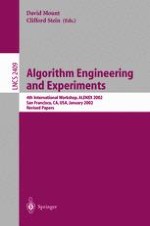2002 | Book
Algorithm Engineering and Experiments
4th International Workshop, ALENEX 2002 San Francisco, CA, USA, January 4–5, 2002 Revised Papers
Editors: David M. Mount, Clifford Stein
Publisher: Springer Berlin Heidelberg
Book Series : Lecture Notes in Computer Science
Included in: Professional Book Archive
